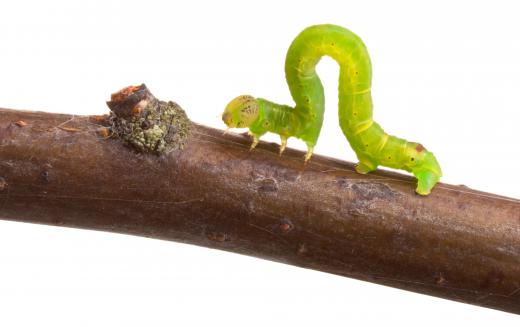What are Larvae?
 Michael Anissimov
Michael Anissimov
A larva is a juvenile form of an animal that differs substantially in its body morphology and internal organs than the adult organism. For instance, a caterpillar is the larval form of a butterfly. In contrast, juvenile humans are pretty much the same as adult humans, only smaller. A larval stage is common among insects, fish, amphibians, crustaceans, and certain mollusks, echinoderms, annelids, and others. Some species actually evolve into an exclusively larval form and remain there. The process of turning from a larvae into an adult is called metamorphosis.
The larval stage is a stepping stone to adulthood for these animals. There are various evolutionary benefits to having a larval stage: generally, the stage is better optimized for its small size and appetite. This is especially true for animal species that tend to have a "quantity over quality" evolutionary strategy -- in some cases, it would be a waste to produce thousands of adults directly, as many of them would die anyway, and would be more energy-hungry than larval forms. The larval form gives these animals a "trial period" -- a low-energy way to get into the game of living. If the larval form collects enough food, either through its own efforts or with the assistance of adults, it merits graduation to adult form, and usually, the ability to produce its own offspring.

Larva are given different names depending on the animal they are associated with. They often have a fat, worm-like appearance (especially among insects), other times a smaller version of the adult but with important morphological differences. The variation in larval forms is almost as great as the variation in the adult forms they grow into. Most crustacean larvae are called a nauplius, lobster larvae are zoeas, true bug larvae are nymphs, dragonfly larvae are naiads, beetles, bees, and wasps have grubs, flies have maggots, mosquito larvae are known as wigglers, certain mollusk and annelid larvae are called trochophores, butterflies and moths have caterpillars, eel larvae are called leptocephaluses, amphibians have tadpoles, and fish larvae are simply called larvae.

Larvae may either be stationary, almost like a fetus, such as wasp larvae, which subsist on food brought back to the nest by adults. Other larvae are active predators or parasites, like botfly larvae, which infects humans. For insects, larvae are often laid in garbage or stagnant water. In controlling insects, it can be helpful to attack the larval stage rather than the adults themselves. For instance, to eliminate mosquitoes, it is advisable to drain standing pools of water, where the larvae are laid. This strategy has been pursued for decades worldwide. A particularly effective example was during the construction of the Panama Canal, where an effective pest control program almost eliminated the risk of malaria for the canal workers.
AS FEATURED ON:
AS FEATURED ON:


















Discussion Comments
@clintflint - Actually, there are still hospitals which will use medical maggots to clean out particular kinds of wounds. People do tend to have an instinctive disgust of them though, which is perhaps why they aren't used very often.
@MrsPramm - There are a wide variety of larvae though and not all of them are traditionally seen with revulsion. Silkworms, for example, are still cultivated in huge numbers and are a valuable and cherished domesticated animal. There are plenty of people around the world who eat various kinds of household larvae as well. Whitebait is eaten by a lot of people even in the Western world and it's a type of fish larvae.
And tadpoles are considered to be larvae. I remember keeping them as pets when I was a kid and I certainly didn't think they were repulsive.
Even maggots were once used as a very effective means of cleaning out wounds, since many of them will only eat decayed flesh and will avoid living tissues.
It's kind of weird how larvae are almost always seen as pretty gross by humans. I mean, most of the time they aren't actually harmful in that form, even if they are in their adult form, like mosquitoes. But I can't suppress the shudder I get when I think of meal-worms or maggots or other kinds of larvae.
I guess it might be because they often inhabit food that has gone off and isn't good to eat, so it's a kind of survival instinct to be repulsed by them.
Post your comments